Lessons Learned from Positive Energy District (PED) Projects: Cataloguing and Analysing Technology Solutions in Different Geographical Areas in Europe
Abstract
:1. Introduction
2. Literature Review
3. Materials and Methods
Materials
4. Results
5. Discussion
Critical Reflection on Technological Choices
6. Conclusions
- A general trend in the establishment of PEDs in Northern and Central Europe was noted, to the disadvantage of the south, which could be due to a potentially lower institutional and start-up presence in the south;
- The most frequently used type of PED is the dynamic PED, which would seem to be the most effective and adaptable form of PED for current urban conditions. However, the virtual PED could offer more effective solutions especially in Northern Europe to counter the energy mismatch;
- Recurring choices were noted in the selection of technologies for the proper functioning of PEDs, declined from time to time in different ways to suit the needs of the area. When technological choices differed, the reason was the presence of previous regional or city programmes that aimed at promoting the development and use of a specific technology. Some examples are the choices made by Alkmaar, with the use of hydrogen fuel cell, and Leipzig, with solar thermal;
- Among the most widely used technologies is solar PV energy technologies, which could be due to its lower price, ease of installation and the large presence of companies capable of guaranteeing proper maintenance. In addition, the district heating network is also more common, which could be due to the high effectiveness and efficiency of this technology and their greater safety. Moreover, E-mobility has a large presence;
- Despite being one of the most energy-efficient renewable energy sources, wind energy was found to have lower use. Actually, only the Espoo case study (Sparcs) has adopted it in a virtual way, as it is among the green certified electricity solutions. The reasons behind its low use could be the difficulty of installation in the urban context, the high cost of installation and maintenance, landscape deterrents and social resistance;
- A progressive focus on solutions related to the production, storage and distribution of heat was noted in the progression towards Northern Europe, probably due to the geographical and climatic typical needs of those territories;
- There was an acceleration in the electrification process of PEDs regarding e-mobility and heat generation technologies (especially large heat pumps in district networks). One of the possible solutions to this increased demand for electricity could, in our opinion, be found in a greater exploitation of wind energy sources and through the utilisation of electricity produced by nuclear reactors on a regional or national scale;
- Technological solutions at the district scale were often preferred to building-integrated solutions, this is probably due to higher efficiency with larger units, better control and management and distribution of energy in the territory. However, one disadvantage is the higher energy losses associated with long distribution lines;
- In order to promote the development of PED on a large scale, it would be desirable to develop a high level of planning that considers the entire territory and systematises the development of PED on a regional scale. This way, a network of PEDs and greater efficiency could be achieved. For this reason, a good solution, in our opinion, could be the use of the new territorial acupuncture methodology.
Author Contributions
Funding
Institutional Review Board Statement
Informed Consent Statement
Data Availability Statement
Acknowledgments
Conflicts of Interest
Appendix A
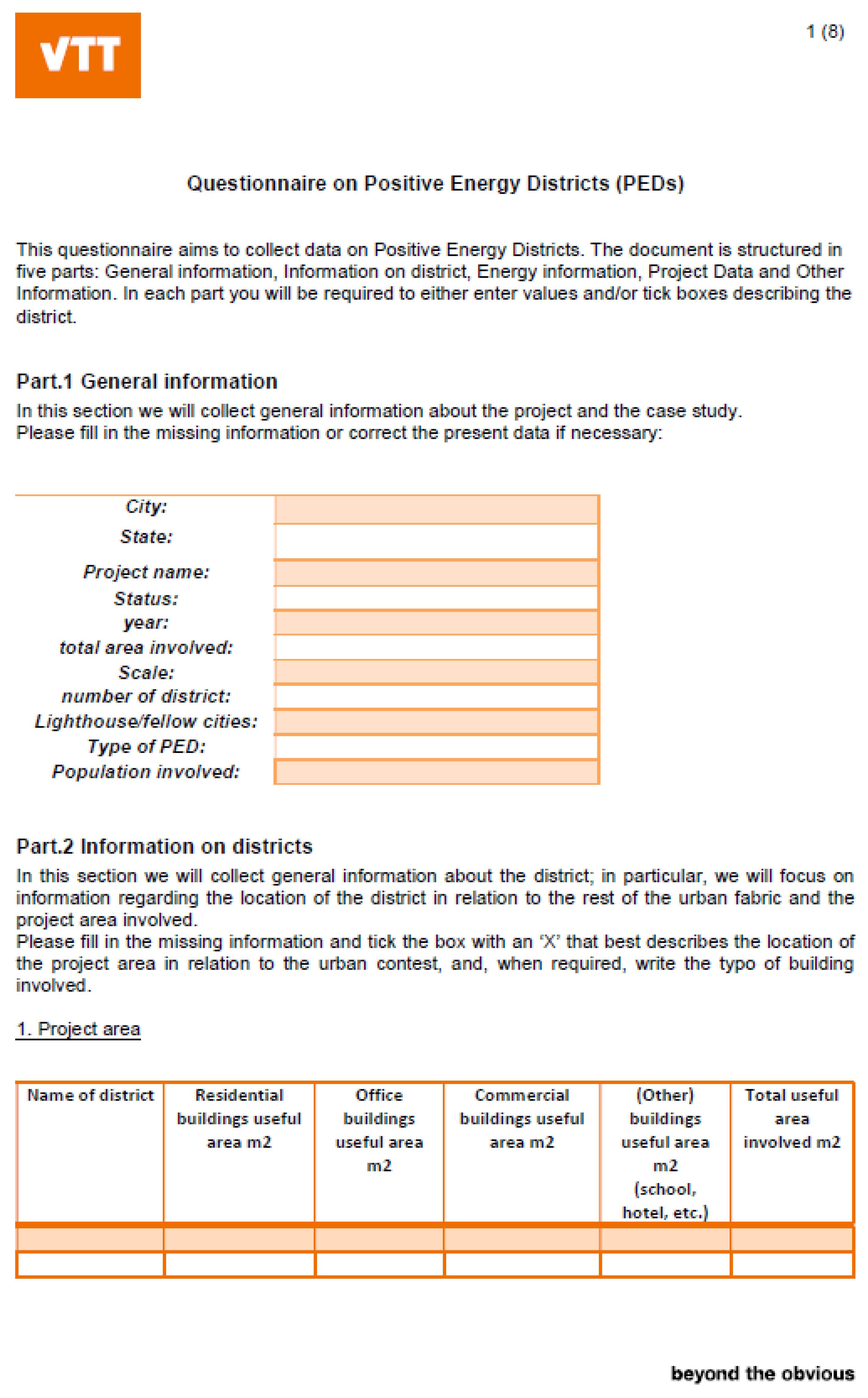

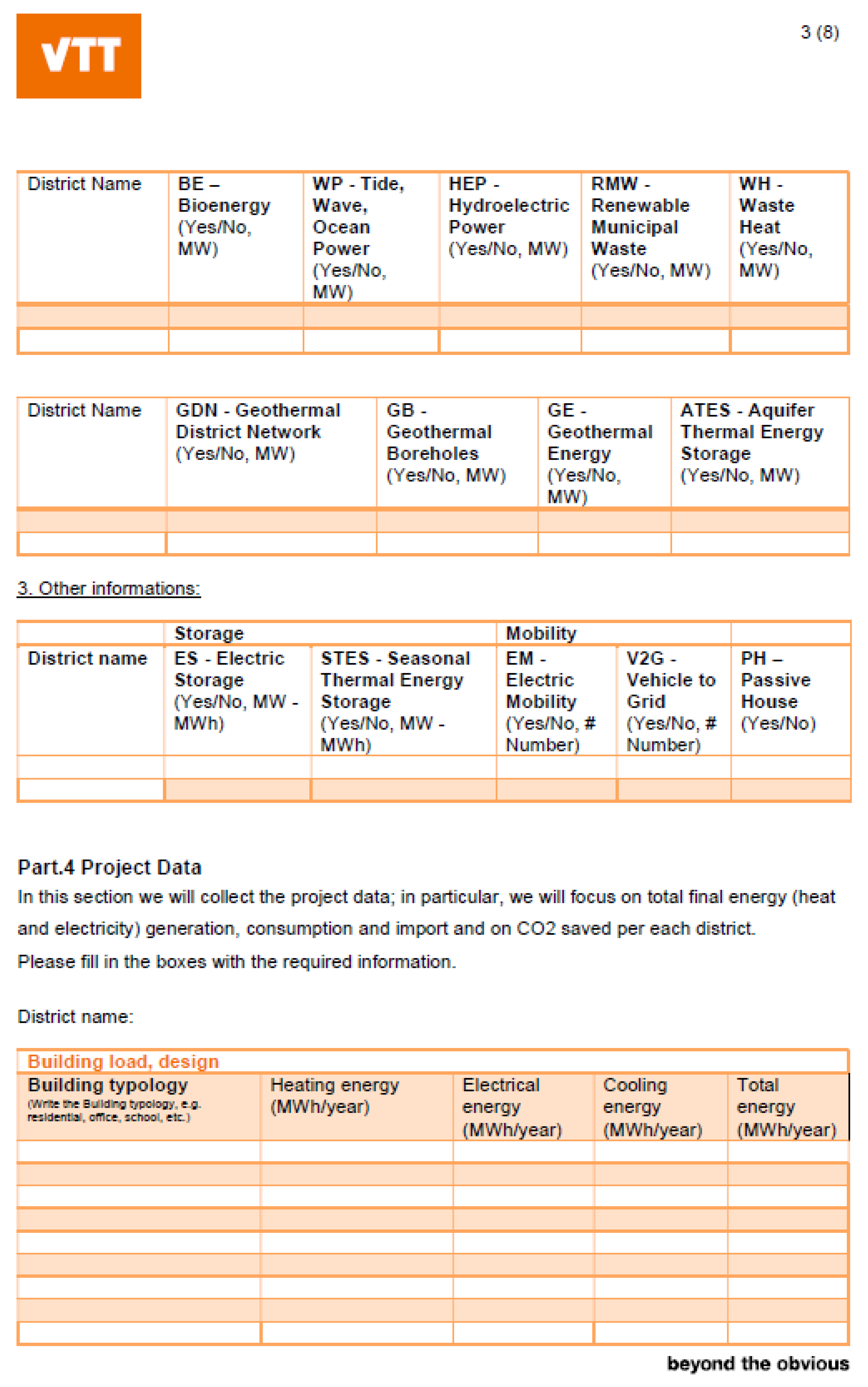

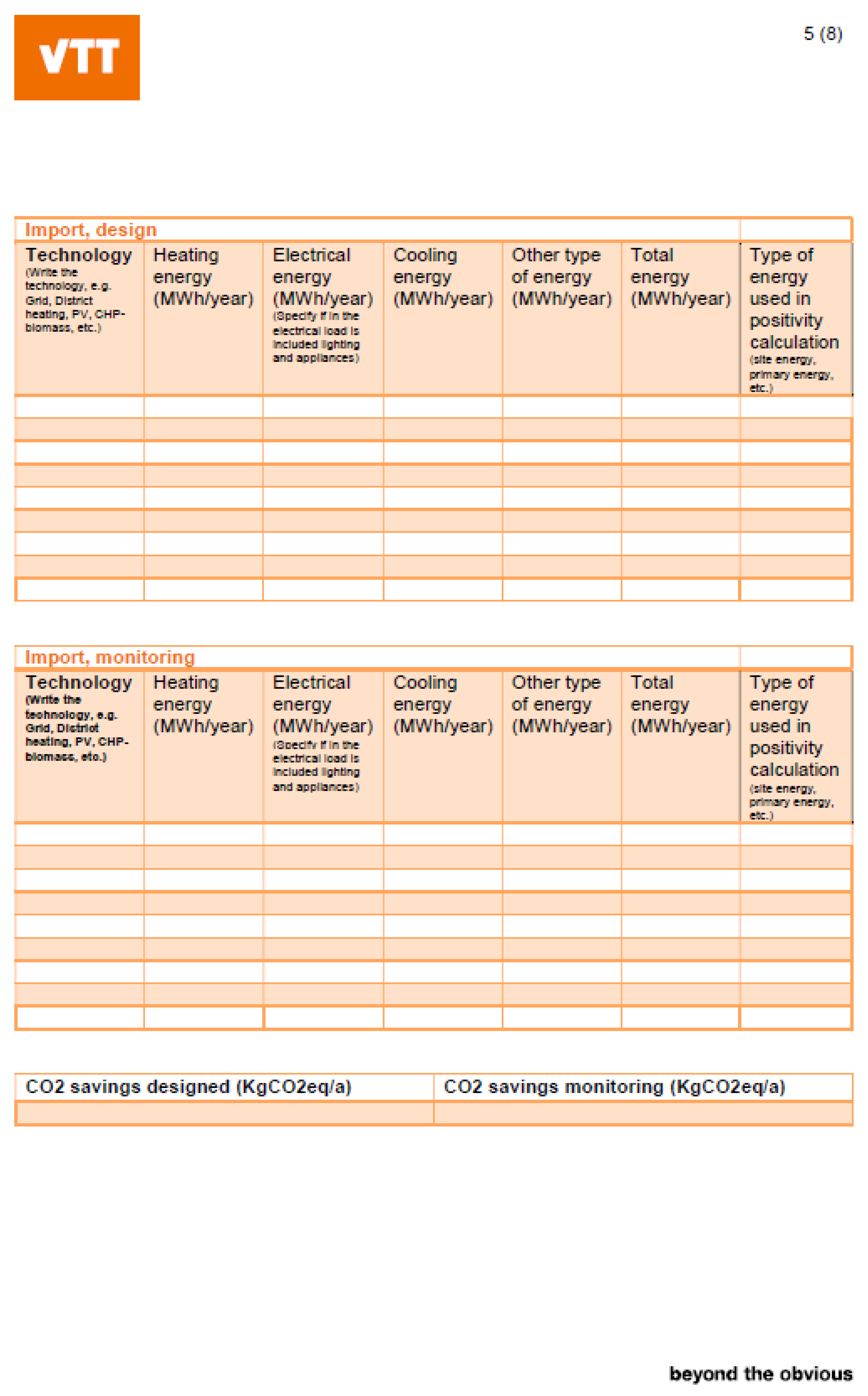
References
- Godfray, H.C.J.; Beddington, J.R.; Crute, I.R.; Haddad, L.; Lawrence, D.; Muir, J.F.; Pretty, J.; Robinson, S.; Thomas, S.M.; Toulmin, C. Food Security: The Challenge of Feeding 9 Billion People. Science 2010, 327, 812–818. [Google Scholar] [CrossRef] [PubMed] [Green Version]
- Walther, G.-R.; Post, E.; Convey, P.; Menzel, A.; Parmesan, C.; Beebee, T.J.C.; Fromentin, J.-M.; Hoegh-Guldberg, O.; Bairlein, F. Ecological responses to recent climate change. Nature 2002, 416, 389–395. [Google Scholar] [CrossRef] [PubMed]
- Rayner, N.A.; Parker, D.E.; Horton, E.B.; Folland, C.K.; Alexander, L.V.; Rowell, D.P.; Kent, E.C.; Kaplan, A. Global analyses of sea surface temperature, sea ice, and night marine air temperature since the late nineteenth century. J. Geophys. Res. 2003, 108, 4407. [Google Scholar] [CrossRef] [Green Version]
- Parmesan, C.; Yohe, G. A globally coherent fingerprint of climate change impacts across natural systems. Nature 2003, 421, 37–42. [Google Scholar] [CrossRef]
- Foley, J.A.; DeFries, R.; Asner, G.P.; Barford, C.; Bonan, G.; Carpenter, S.R.; Chapin, F.S.; Coe, M.T.; Daily, G.C.; Gibbs, H.K.; et al. Global consequences of land use. Science 2005, 309, 570–574. [Google Scholar] [CrossRef] [Green Version]
- United Nations. Paris Agreement—Status of Ratification. In Proceedings of the 21st Paris Climate Change Conference, Paris, France, 30 November–11 December 2015. [Google Scholar]
- Mitchell, D.; Allen, M.R.; Hall, J.W.; Muller, B.; Rajamani, L.; Le Quéré, C. The myriad challenges of the Paris Agreement. Philos. Trans. R. Soc. A Math. Phys. Eng. Sci. 2018, 376, 20180066. [Google Scholar] [CrossRef]
- United Nations. What Is the Paris Agreement? United Nations Climate Change; UNFCCC: Rio de Janeiro, Brazil; New York, NY, USA, 2015. [Google Scholar]
- United Nations. Adoption of the Paris Agreement. In Proceedings of the 2015 United Nations Climate Change Conference, Paris, France, 30 November–12 December 2015; p. 21932. [Google Scholar]
- United Nations. Summary of the Paris Agreement; United Nations Framework Convention on Climate Change: Rio de Janeiro, Brazil; New York, NY, USA, 2015. [Google Scholar]
- United Nations. Paris Agreement COP21. In Proceedings of the 2015 United Nations Climate Change Conference, Paris, France, 30 November–12 December 2015. [Google Scholar]
- Zhao, X.; Ma, X.; Chen, B.; Shang, Y.; Song, M. Challenges toward carbon neutrality in China: Strategies and countermeasures. Resour. Conserv. Recycl. 2022, 176, 105959. [Google Scholar] [CrossRef]
- Zou, C.; Xue, H.; Xiong, B.; Zhang, G.; Pan, S.; Jia, C.; Wang, Y.; Ma, F.; Sun, Q.; Guan, C.; et al. Connotation, innovation and vision of “carbon neutrality”. Nat. Gas Ind. B 2021, 8, 523–537. [Google Scholar] [CrossRef]
- Wang, F.; Harindintwali, J.D.; Yuan, Z.; Wang, M.; Li, S.; Yin, Z.; Huang, L.; Fu, Y.; Li, L.; Chang, S.X.; et al. Technologies and perspectives for achieving carbon neutrality. Innovation 2021, 2, 100180. [Google Scholar] [CrossRef]
- Pulselli, R.M.; Broersma, S.; Martin, C.L.; Keeffe, G.; Bastianoni, S.; van den Dobbelsteen, A. Future city visions. The energy transition towards carbon-neutrality: Lessons learned from the case of Roeselare, Belgium. Renew. Sustain. Energy Rev. 2021, 137, 110612. [Google Scholar] [CrossRef]
- Bonoli, A.; Zanni, S.; Serrano-Bernardo, F. Sustainability in Building and Construction within the Framework of Circular Cities and European New Green Deal. The Contribution of Concrete Recycling. Sustainability 2021, 13, 2139. [Google Scholar] [CrossRef]
- Špaček, R.; Legény, J.; Gregor, P. Challenge and response at all levels in sustainable architecture education. World Trans. Eng. Technol. Educ. 2020, 18, 18–23. [Google Scholar]
- Wolf, S.; Teitge, J.; Mielke, J.; Schütze, F.; Jaeger, C. The European Green Deal—More Than Climate Neutrality. Intereconomics 2021, 56, 99–107. [Google Scholar] [CrossRef]
- Salvia, M.; Reckien, D.; Pietrapertosa, F.; Eckersley, P.; Spyridaki, N.-A.; Krook-Riekkola, A.; Olazabal, M.; De Gregorio Hurtado, S.; Simoes, S.G.; Geneletti, D.; et al. Will climate mitigation ambitions lead to carbon neutrality? An analysis of the local-level plans of 327 cities in the EU. Renew. Sustain. Energy Rev. 2021, 135, 110253. [Google Scholar] [CrossRef]
- Magrini, A.; Lentini, G.; Cuman, S.; Bodrato, A.; Marenco, L. From nearly zero energy buildings (NZEB) to positive energy buildings (PEB): The next challenge—The most recent European trends with some notes on the energy analysis of a forerunner PEB example. Dev. Built Environ. 2020, 3, 100019. [Google Scholar] [CrossRef]
- Kolokotsa, D.; Rovas, D.; Kosmatopoulos, E.; Kalaitzakis, K. A roadmap towards intelligent net zero- and positive-energy buildings. Sol. Energy 2011, 85, 3067–3084. [Google Scholar] [CrossRef]
- Ala-Juusela, M.; Rehman, H.U.; Hukkalainen, M.; Reda, F. Positive Energy Building Definition with the Framework, Elements and Challenges of the Concept. Energies 2021, 14, 6260. [Google Scholar] [CrossRef]
- Lindholm, O.; Rehman, H.U.; Reda, F. Positioning Positive Energy Districts in European Cities. Buildings 2021, 11, 19. [Google Scholar] [CrossRef]
- Marotta, I.; Guarino, F.; Longo, S.; Cellura, M. Environmental Sustainability Approaches and Positive Energy Districts: A Literature Review. Sustainability 2021, 13, 13063. [Google Scholar] [CrossRef]
- Becchio, C.; Bottero, M.C.; Corgnati, S.P.; Dell’Anna, F. Decision making for sustainable urban energy planning: An integrated evaluation framework of alternative solutions for a NZED (Net Zero-Energy District) in Turin. Land Use Policy 2018, 78, 803–817. [Google Scholar] [CrossRef]
- Vandevyvere, H.; Ahlers, D.; Alpagut, B.; Cerna, V.; Cimini, V.; Haxhija, S.; Hukkalainen, M.; Kuzmic, M.; Livik, K.; Padilla, M.; et al. Positive Energy Districts Solution Booklet; European Union: Brussels, Belgium, 2020. [Google Scholar]
- Hedman, Å.; Rehman, H.U.; Gabaldón, A.; Bisello, A.; Albert-Seifried, V.; Zhang, X.; Guarino, F.; Grynning, S.; Eicker, U.; Neumann, H.-M.; et al. IEA EBC Annex83 positive energy districts. Buildings 2021, 11, 130. [Google Scholar] [CrossRef]
- Ala-Juusela, M.; Crosbie, T.; Hukkalainen, M. Defining and operationalising the concept of an energy positive neighbourhood. Energy Convers. Manag. 2016, 125, 133–140. [Google Scholar] [CrossRef] [Green Version]
- Zhang, X.; Penaka, S.R.; Giriraj, S.; Sánchez, M.N.; Civiero, P.; Vandevyvere, H. Characterizing Positive Energy District (PED) through a Preliminary Review of 60 Existing Projects in Europe. Buildings 2021, 11, 318. [Google Scholar] [CrossRef]
- Lorenzoni, I.; Pidgeon, N.F. Public Views on Climate Change: European and USA Perspectives. Clim. Chang. 2006, 77, 73–95. [Google Scholar] [CrossRef]
- Stoate, C.; Báldi, A.; Beja, P.; Boatman, N.; Herzon, I.; van Doorn, A.; de Snoo, G.; Rakosy, L.; Ramwell, C. Ecological impacts of early 21st century agricultural change in Europe—A review. J. Environ. Manag. 2009, 91, 22–46. [Google Scholar] [CrossRef] [PubMed]
- Olesen, J.E.; Bindi, M. Consequences of climate change for European agricultural productivity, land use and policy. Eur. J. Agron. 2002, 16, 239–262. [Google Scholar] [CrossRef]
- Davis, S.J.; Caldeira, K. Consumption-based accounting of CO2 emissions. Proc. Natl. Acad. Sci. USA 2010, 107, 5687–5692. [Google Scholar] [CrossRef] [Green Version]
- Lindner, M.; Maroschek, M.; Netherer, S.; Kremer, A.; Barbati, A.; Garcia-Gonzalo, J.; Seidl, R.; Delzon, S.; Corona, P.; Kolström, M.; et al. Climate change impacts, adaptive capacity, and vulnerability of European forest ecosystems. For. Ecol. Manag. 2010, 259, 698–709. [Google Scholar] [CrossRef]
- Wawrzyniak, D. CO2 Emissions in the Visegrad Group Countries and the European Union Climate Policy. Comp. Econ. Res. Central East. Eur. 2020, 23, 73–91. [Google Scholar] [CrossRef]
- Billson, M.; Pourkashanian, M. The Evolution of European CCS Policy. Energy Procedia 2017, 114, 5659–5662. [Google Scholar] [CrossRef]
- Montanarella, L.; Panagos, P. The relevance of sustainable soil management within the European Green Deal. Land Use Policy 2021, 100, 104950. [Google Scholar] [CrossRef]
- Claeys, G.; Tagliapietra, S.; Zachmann, G. How to Make the European Green Deal Work; Bruegel: Brussels, Belgium, 2019. [Google Scholar]
- Boeri, A.; Longo, D.; Palma, M. Climate-neutral limate-neutral and smart cities: A European polices’ overview. WIT Trans. Ecol. Environ. 2021, 253, 3–14. [Google Scholar] [CrossRef]
- Bossi, S.; Gollner, C.; Theierling, S. Towards 100 Positive Energy Districts in Europe: Preliminary Data Analysis of 61 European Cases. Energies 2020, 13, 6083. [Google Scholar] [CrossRef]
- Bartholmes, J. Smart Cities and Communities SCC1-2020; European Commission: Brussels, Belgium, 2020. [Google Scholar]
- Bilotta, S.; Nesi, P.; Paoli, I. Real-time System for Short- and Long-Term Prediction of Vehicle Flow. In Proceedings of the 2020 IEEE International Conference on Smart Data Services, SMDS, Virtual, 18–24 October 2020; pp. 97–104. [Google Scholar] [CrossRef]
- Haarstad, H.; Wathne, M.W. Are smart city projects catalyzing urban energy sustainability? Energy Policy 2019, 129, 918–925. [Google Scholar] [CrossRef]
- Calzada, I. Replicating Smart Cities: The City-to-City Learning Programme in the Replicate EC-H2020-SCC Project. Smart Cities 2020, 3, 978–1003. [Google Scholar] [CrossRef]
- Gouveia, J.P.; Seixas, J.; Palma, P.; Duarte, H.; Luz, H.; Cavadini, G.B. Positive Energy District: A Model for Historic Districts to Address Energy Poverty. Front. Sustain. Cities 2021, 3, 648473. [Google Scholar] [CrossRef]
- Maestosi, P.C. Smart Cities and Positive Energy Districts: Urban Perspectives in 2020. Energies 2021, 14, 2351. [Google Scholar] [CrossRef]
- Soriano, F.H.; Mulatero, F. EU Research and Innovation (R&I) in renewable energies: The role of the Strategic Energy Technology Plan (SET-Plan). Energy Policy 2011, 39, 3582–3590. [Google Scholar] [CrossRef]
- Turci, G.; Alpagut, B.; Civiero, P.; Kuzmic, M.; Pagliula, S.; Massa, G.; Albert-Seifried, V.; Seco, O.; Soutullo, S. A Comprehensive PED-Database for Mapping and Comparing Positive Energy Districts Experiences at European Level. Sustainability 2021, 14, 427. [Google Scholar] [CrossRef]
- Derkenbaeva, E.; Vega, S.H.; Hofstede, G.J.; van Leeuwen, E. Positive energy districts: Mainstreaming energy transition in urban areas. Renew. Sustain. Energy Rev. 2022, 153, 111782. [Google Scholar] [CrossRef]
- Krangsås, S.G.; Steemers, K.; Konstantinou, T.; Soutullo, S.; Liu, M.; Giancola, E.; Prebreza, B.; Ashrafian, T.; Murauskaitė, L.; Maas, N. Positive Energy Districts: Identifying Challenges and Interdependencies. Sustainability 2021, 13, 10551. [Google Scholar] [CrossRef]
- Castillo-Calzadilla, T.; Alonso-Vicario, A.; Borges, C.E.; Martin, C. E-Mobility in Positive Energy Districts. Buildings 2022, 12, 264. [Google Scholar] [CrossRef]
- Moreno, A.G.; Vélez, F.; Alpagut, B.; Hernández, P.; Montalvillo, C.S. How to Achieve Positive Energy Districts for Sustainable Cities: A Proposed Calculation Methodology. Sustainability 2021, 13, 710. [Google Scholar] [CrossRef]
- Frolova, M.; Centeri, C.; Benediktsson, K.; Hunziker, M.; Kabai, R.; Scognamiglio, A.; Martinopoulos, G.; Sismani, G.; Brito, P.; Muñoz-Cerón, E.; et al. Effects of renewable energy on landscape in Europe: Comparison of hydro, wind, solar, bio-, geothermal and infrastructure energy landscapes. Hung. Geogr. Bull. 2019, 68, 317–339. [Google Scholar] [CrossRef] [Green Version]
- Miskolczi, M.; Földes, D.; Munkácsy, A.; Jászberényi, M. Urban mobility scenarios until the 2030s. Sustain. Cities Soc. 2021, 72, 103029. [Google Scholar] [CrossRef]
- Zhang, X.; Shen, J.; Saini, P.K.; Lovati, M.; Han, M.; Huang, P.; Huang, Z. Digital Twin for Accelerating Sustainability in Positive Energy District: A Review of Simulation Tools and Applications. Front. Sustain. Cities 2021, 3, 663269. [Google Scholar] [CrossRef]
- Shahat, E.; Hyun, C.; Yeom, C. City Digital Twin Potentials: A Review and Research Agenda. Sustainability 2021, 13, 3386. [Google Scholar] [CrossRef]
- Jones, D.; Snider, C.; Nassehi, A.; Yon, J.; Hicks, B. Characterising the Digital Twin: A systematic literature review. CIRP J. Manuf. Sci. Technol. 2020, 29, 36–52. [Google Scholar] [CrossRef]
- Ranta, M.; Hajduk, P.; Tartia, J.; Santala, S.; Tukia, T.; Juhmen, J.; Boldt, D.; Häsä, S.; Töyräs, J.; Ekelund, E.; et al. D3.5 EV Mobility Integration and Its Impacts in Espoo. 2022. Available online: https://www.sparcs.info/about/deliverables/d305-ev-mobility-integration-and-its-impacts-espoo (accessed on 18 December 2022).
- Klobut, K.; Piira, K.; Abdurafikov, R.; Laitinen, A.; Juslin, A.; Juhmen, J.; Saari, M.; Soinio, T.; Laakso, S.; Tukia, T.; et al. D3.4 Interoperability of Holistic Energy Systems in Espoo. 2022. Available online: https://www.sparcs.info/about/deliverables/d304-interoperability-holistic-energy-systems-espoo (accessed on 18 December 2022).
- Fatima, Z. D3.6 Optimizing People Flow and User Experience for Energy Positive Districts. 2022. Available online: https://www.sparcs.info/about/deliverables/d306-optimizing-people-flow-and-user-experience-energy-positive-districts (accessed on 17 December 2022).
- Wanne, E.; Tartia, J.; Juslin, A.; Mäkinen, J.; Hukkalainen, M.; Fatima, Z.; Klobut, K.; Piira, K.; Ranta, M.; Hajduk, p.; et al. D3.3 Implemented Demonstrations of Solutions for Energy Positive Blocks in Espoo. 2022. Available online: https://www.sparcs.info/about/deliverables/d303-implemented-demonstrations-solutions-energy-positive-blocks-espoo (accessed on 28 November 2022).
- Lei, L. D4.2 Midterm Report on the Implemented Solutions for Energy Positive Blocks in Leipzig. Pfd. 2021. Available online: https://www.sparcs.info/about/deliverables/d402-midterm-report-implemented-solutions-energy-positive-blocks-leipzig (accessed on 18 December 2022).
- Riedel, N.; Müller, I.; Albrecht, S.; Jelinek, E.; Kühne, J.M.; Schutt, T.; Vöhl, A.; Kondziella, H.; Baumet, S.; Bolognesi, P.; et al. D4.3 Implemented Demonstrations of Solutions for Energy Positive Blocks in Leipzig. 2022, pp. 1–125. Available online: https://www.sparcs.info/about/deliverables/d403-implemented-demonstrations-solutions-energy-positive-blocks-leipzig (accessed on 18 December 2022).
- City of Leipzig. D4.01 Detailed Plan of the Leipzig Smart City Lighthouse Demonstrations. 2020. Available online: https://www.sparcs.info/about/deliverables/d401-detailed-plan-leipzig-smart-city-lighthouse-demonstrations (accessed on 28 November 2022).
- Martinopoulos, G.; Nikolopoulos, N.; Tsompanidou, E.; Matsoukas, S.; Angelakoglou, K.; Paraskevi Gkiourka, K.K. D 4.6 Planning and Management of Open Innovation Challenges in Dijon and Turku—V1. 2022. Available online: https://h2020response.eu/wp-content/uploads/2022/05/D4.6-Planning-and-management-of-Open-Innovation-Challenges-in-Dijon-Turku-%E2%80%93-V1.pdf/ (accessed on 14 December 2022).
- Lanna, M.; Py, E. Response Data Governance and CIP Operational Framework. 2022. Available online: https://h2020response.eu/wp-content/uploads/2022/05/D3.2-RESPONSE-Data-Governance-and-CIP-Operational-Framework.pdf (accessed on 15 December 2022).
- Rouchette, H. D1.1 Elicitation of Citizens and Stakeholder Requirements, Risk Perception and User Acceptance Determinants. 2021. Available online: https://h2020response.eu/wp-content/uploads/2022/05/D1.1-Elicitation-of-citizens-and-stakeholder-requirements-risk-perception-and-user-acceptance-determinants.pdf (accessed on 28 November 2022).
- Evens, C. D1.5 Master City Plans for TA#3 Sustainable Energy Storage. 2021. Available online: https://h2020response.eu/wp-content/uploads/2022/05/D1.5-Master-City-Plans-for-TA3-Sustainable-Energy-Storage.pdf (accessed on 28 November 2022).
- Shemeikka, J. D1.3 Master City Plans for TA#1 Positive Energy Building Systems. 2021. Available online: https://h2020response.eu/wp-content/uploads/2022/05/D1.3-Master-City-Plans-for-TA1-Positive-Energy-Building-Systems.pdf (accessed on 13 December 2022).
- Néstor Rodrfguez Pérez, R.C.A. D1.2 Assessment of Smart Cities Regulatory and Legal Environment—V1. 2021. Available online: https://h2020response.eu/wp-content/uploads/2022/05/D1.2-Assessment-of-Smart-Cities-Regulatory-and-Legal-Environment-V1.pdf (accessed on 13 November 2022).
- Kallenbach, M. Matthijs Janssen Paul Roßteutscher Thomas van de Voort, ir Determining Critical Factors in the Atelier Positive Energy District Pilot in Buiksloterham Mark van Wees. 2021. Available online: https://smartcity-atelier.eu/app/uploads/ATELIER-Critical_learning_factors-report.pdf (accessed on 28 November 2022).
- García, C.; Urrutia, K.; Muñoz, I.; López, A.; Vallejo, E.; Rodríguez, C.; Verspeek, F.; Nathalia, K.; Andonegui, C.; Molinete, B. Deliverable 2.3: Common Methodological Framework for Vision Development. 2021. Available online: https://smartcity-atelier.eu/outcomes/deliverables/d2-3/ (accessed on 13 December 2022).
- DEUSTO, Version, D.; Level, D. Deliverable 1.7: Open Access Research Data Atelier. 2020. Available online: https://smartcity-atelier.eu/outcomes/deliverables/d1-7/ (accessed on 28 November 2022).
- Van Doornink, M. Amsterdam Climate Office New Amsterdam Climate; City of Amsterdam: Amsterdam, The Netherlands, 2016; pp. 1–6. Available online: https://smartcity-atelier.eu/app/uploads/RoadmapAmsterdam-Climate-Neutral-2050-full-version-ENG.Pdf (accessed on 17 December 2022).
- Remmele, B. Dissemination & Communication Strategy Plan; Atelier: Amsterdam, The Netherlands, 2020; pp. 1–50. Available online: https://smartcity-atelier.eu/outcomes/deliverables/d10-8/ (accessed on 23 November 2022).
- University of Deusto, Amsterdam University of Applied Science, Paul Scherrer Institute, Atelier Monitoring and Evaluation Framework deliverable 9.1: Repository of Definitions of Terms, Key Characteristics Archetypes, and a Set of KPIs WP9, Task 9.1. Repository of Definitions of Terms, Key Characteristics Archetypes, and a Set of KPIs. 2020. Available online: https://smartcity-atelier.eu/outcomes/deliverables/d9-1/ (accessed on 15 November 2022).
- Waag Deu Auas D7.1: Citizen and Stakeholder Engagement Plans. 2021. 2021. Available online: https://smartcity-atelier.eu/outcomes/deliverables/d7-1/ (accessed on 23 November 2022).
- DEUSTO. Deliverable 1.3: Data Management Plan. 2021. 2020. Available online: https://smartcity-atelier.eu/outcomes/deliverables/d1-3/ (accessed on 15 November 2022).
- Rev, T. Deliverable 3.1: The PED Innovation Atelier Organisation Document. 2021, pp. 1–55. Available online: https://smartcity-atelier.eu/outcomes/deliverables/d3-1/ (accessed on 15 November 2022).
- Remmele, B. The ATELIER Project. Citizen-Driven Positive Energy Districts in Amsterdam, Bilbao and beyond Smart City, Smart Mobility, Horizon 2020, Lighthouse Cities. 2020, pp. 50–52. Available online: https://smartcity-atelier.eu/news/international-strategies-article-introducing-atelier/ (accessed on 28 November 2022).
- Arrizabalaga, E.; García-Gusano, D.; Hermoso, N.; Muñoz, I.; Fernandez, N.; Alpagut, B.; Olivadese, R.; Dourlens, S.; Action, I. D1.3-Tools for Modelling Energy Demand, Supply Side, Simulation of Scenarios and Estimation of Impacts WP1, Task 1.3 November 2020 [M24].pdf; 2020; pp. 1–147. Available online: https://makingcity.eu/wp-content/uploads/2021/12/MakingCity_D1_3_Tools_for_modelling_Final.pdf (accessed on 27 November 2022).
- De Torre, C.; Rodriguez, C.; Vasallo, A. Making City. D1.2—City Diagnosis: Analysis of Existing City Plans. 2020, pp. 1–395. Available online: https://makingcity.eu/wp-content/uploads/2020/09/MakingCity_D1_2_City_Diagnosis_analysis_of_existing_city_plans_Final_V1-2.pdf (accessed on 27 November 2022).
- Rankinen, J.-A.; Lakkala, S.; Haapasalo, H.; Hirvonen-Kantola, S. Stakeholder management in PED projects: Challenges and management model. Int. J. Sustain. Energy Plan. Manag. 2022, 34, 91–106. [Google Scholar] [CrossRef]
- Schouten, C.; Brezet, H. The Urban Financial Metabolism Model: Quantifying the Societal Impact of Residential Energy Poverty in Groningen, the Netherlands. 2020. Available online: https://makingcity.eu/wp-content/uploads/2021/02/Schouten_395366_Research-Project-Report-edition-for-MAKING-CITY-website.pdf (accessed on 28 November 2022).
- Montalvillo, C.S.; Fredy, J.; Jaramillo, V.; Cartif, F.; Belver, A.V.; Rankinen, J.A.; Lakkala, S.; Haapasalo, H.; Hirvonen-Kantola, S.; Name, F.; et al. VI Congreso Edificios Energía Casi Nula Proyecto Making-City: Tres Distritos De Energía Positiva En Dos Ciudades Faro (Goningen Y Oulu). Int. J. Sustain. Energy Plan. Manag. 2020, 34, 1–147. [Google Scholar]
- Kerrigan, R.; Purshouse, N.; De Donatis, L.; Neu, O. D4.1: Limerick DST (Integrated Modelling and Decision Support Tool) Including Training Manuals/Videos +CityxChange Project Title Positive City Exchange. 2020. Available online: https://cityxchange.eu/knowledge-base/d4-1-limerick-dst-integrated-modelling-and-decision-support-tool-including-training-manuals-videos/ (accessed on 13 December 2022).
- Package, C.W.; Lccc, J.T.; Ul, H.F.; Lccc, R.W.; Lccc, T.C. D4.8: Limerick Citizen Observatory. 2022. Available online: https://cityxchange.eu/knowledge-base/d4-8-limerick-citizen-observatory/ (accessed on 14 December 2022).
- Walsh, G.; Fitzgerald, H.; Lyes, M.; Mee, A. +CityxChange D4.10: Limerick Innovation Lab Solutions Catalogue 2. 2022, pp. 1–60. Available online: https://cityxchange.eu/knowledge-base/d4-10-limerick-innovation-lab-solutions-catalogue-2/ (accessed on 22 December 2022).
- Sørum, A.B.; Ove Berthelsen, B.; Skoglund, T.R.; Bratseth, E.A.; Nørbech, T.; Lauvland, M.; Jensen, T.; Riedesel, K.; Gulbrandsøy, E.; Ahlers, D.; et al. D5.13: +Trondheim eMaaS Demonstration. Available online: https://cityxchange.eu/knowledge-base/d5-13-trondheim-emaas-demonstration/ (accessed on 28 November 2022).
- Introduction to Cityxchange. Pptx. Available online: https://view.officeapps.live.com/op/view.aspx?src=https%3A%2F%2Fcityxchange.eu%2Fwp-content%2Fuploads%2F2019%2F10%2FIntroduction_CxC-3.pptx&wdOrigin=BROWSELINK (accessed on 28 November 2022).
- Antolic, M.; Wright, S. D4.4: Limerick DPEB Implementation Guide 1. 2021. Available online: https://cityxchange.eu/knowledge-base/d4-4-limerick-dpeb-implementation-guide-1/ (accessed on 13 December 2022).
- Purshouse, N.; De Donatis, L.; Neu, O.; Kerrigan, R.; Berthelsen, B.O. D5.2: +Trondheim DST Including Training Manuals/Videos +CityxChange Project Title Positive City Exchange. 2021. Available online: https://cityxchange.eu/knowledge-base/d5-2-trondheim-dst-including-training-manuals-videos/ (accessed on 28 November 2022).
- Urban, S.; Package, C.W. D5.7: + Trondheim 2050 Bold City Vision and Guidelines. 2022. Available online: https://cityxchange.eu/knowledge-base/d5-7-trondheim-2050-bold-city-vision-and-guidelines-vision-for-sustainable-urban-transition/ (accessed on 22 December 2022).
- Grabinsky, C.; Riedesel, K.; Haugslett, A. D5.10: Trondheim Innovation Lab Solutions Catalogue (+ Trondheim Implementation of Innovation Playground). 2021. Available online: https://cityxchange.eu/knowledge-base/d5-10-trondheim-innovation-lab-solutions-catalogue/ (accessed on 13 December 2022).
- Package, C.W.; Tk, K.R.; Grabinsky, C.M.; Rk, M.M.; Mansilla, W.A.; Ntnu, D.A. D5.8: + Trondheim Citizen Observatory. 2021. Available online: https://cityxchange.eu/knowledge-base/d5-8-trondheim-citizen-observatory/ (accessed on 17 November 2022).
- Walsh, G.; Mee, A. D4.3: Limerick Innovation Lab Catalogue 1. 2020. Available online: https://cityxchange.eu/knowledge-base/d4-3-limerick-innovation-lab-solutions-catalogue-1/ (accessed on 28 November 2022).
- Gonçalo, J. Project Management Roadmap Technical References Project Acronym Pocityf Project Title a Positive Energy City Transformation Framework. 2021. Available online: https://pocityf.eu/wp-content/uploads/2022/06/POCITYF-864400_D11.2_Project-Management-Roadmap-version-2.pdf (accessed on 26 October 2022).
- Gonçalo, J. D11.4 Quality Assessment, Risk Assessment and Contingency Plans. 2020. Available online: https://pocityf.eu/wp-content/uploads/2022/06/POCITYF-864400_D11.4_Quality-Assessment-Risk-Assessment-and-Contingency-Plans.pdf (accessed on 28 November 2022).
- Serra, L.; Leitão, D.; Michi, C.; Schmid, E.; Bilo, N. Pocityf, D9.1; Pocityf Clustering Action Plan. Pocityf. 2020. Available online: https://pocityf.eu/wp-content/uploads/2020/09/POCITYF-864400_D9.1_Clustering-Action-Plan.pdf (accessed on 28 October 2022).
- Kort, J.; Klösters, M.; de Koning, N. Becoming Sustainable Together with Residents. Participation and Communication Manual for Housing Corporations. Pocityf and Tno. 2022. Available online: https://pocityf.eu/news/becoming-sustainable-together-with-residents-participation-and-communication-manual-for-housing-corporations/ (accessed on 28 November 2022).
- Michi, C.; Material, M.D. D10.5 Multi Dissemination Material Version 2. Pocityf. 2020. Available online: https://pocityf.eu/wp-content/uploads/2020/09/POCITYF-864400_D10.5_Multi-Dissemination-material-version-2.pdf/ (accessed on 13 December 2022).
- Gonçalves, L.; Patrício, L.; Teixeira, J.; Bănică, B.; POCITYF, D. 4.1: Engagement, C. Pocityf Citizen Engagement Plan. Pocityf. 2020. Available online: https://pocityf.eu/wp-content/uploads/2022/06/POCITYF-864400_D4.1_POCITYF-Citizen-Engagement-Plan.pdf (accessed on 25 October 2022).
- Prokscha, S. D11.8 The Data Management Plan. In Practical Guide to Clinical Data Management, 3rd ed.; CRC Press: Boca Raton, FL, USA, 2020; pp. 25–30. [Google Scholar] [CrossRef]
- Kourtzanidis, K.; Angelakoglou, K.; Giourka, P.; Tsarchopoulos, P.; Nikolopoulos, N.; Ioannidis, D.; Kantorovitch, J.; Formiga, J.; Verbeek, K.; de Vries, M.; et al. Technical and Innovation Management Plans. Pocityf. 2020. Available online: https://pocityf.eu/wp-content/uploads/2022/06/POCITYF-864400_D11.7_Technical-and-Innovation-Management-Plans.pdf (accessed on 28 November 2022).
- Kottek, M.; Grieser, J.; Beck, C.; Rudolf, B.; Rubel, F. World map of the Köppen-Geiger climate classification updated. Meteorol. Z. 2006, 15, 259–263. [Google Scholar] [CrossRef] [PubMed]
- Beck, H.E.; Zimmermann, N.E.; McVicar, T.R.; Vergopolan, N.; Berg, A.; Wood, E.F. Present and future Köppen-Geiger climate classification maps at 1-km resolution. Sci. Data 2018, 5, 180214. [Google Scholar] [CrossRef] [PubMed] [Green Version]
- Chen, D.; Chen, H.W. Using the Köppen classification to quantify climate variation and change: An example for 1901–2010. Environ. Dev. 2013, 6, 69–79. [Google Scholar] [CrossRef]
- Fatima, Z.; Pollmer, U.; Santala, S.-S.; Kontu, K.; Ticklen, M. Citizens and Positive Energy Districts: Are Espoo and Leipzig Ready for PEDs? Buildings 2021, 11, 102. [Google Scholar] [CrossRef]
- Hukkalainen, M.; Fatima, Z.; Klobut, K.; Piira, K.; Ranta, M.; Hajduk, P.; Vainio-Kaila, T.; Wanne, E.; Tartia, J.; Bartel, A.; et al. D3.2 Midterm Report on the Implemented Demonstrations of Solutions for Energy Positive Blocks in Espoo. 2021. Available online: https://www.sparcs.info/about/deliverables/d302-midterm-report-implemented-demonstrations-solutions-energy-positive-blocks (accessed on 13 December 2022).
- Martinopoulos, G.; Nikolopoulo, N.; Angelakoglou, K.; Giourka, P. RESPONSE D2.1 KPI Framework. 2021. Available online: https://h2020response.eu/wp-content/uploads/2022/05/D2.1-RESPONSE-KPI-Framework.pdf (accessed on 13 December 2022).
- Technical University of Denmark; Global Wind Atlas. Global Wind Atlas 30. 2021. Available online: https://globalwindatlas.info/en (accessed on 14 November 2022).
- Hukkalainen, M.; Zarrin, F.; Klobut, K.; Lindholm, O.; Ranta, M.; Vainio-Kaila, T.; Wanne, E.; Tartia, J.; Horn, H.; Kontu, K.; et al. D3.1 Detailed Plan of the Espoo Smart City Lighthouse Demonstrations; Sparcs: Espoo, Finland, 2020. [Google Scholar]
- Li, H.; Svendsen, S. District Heating Network Design and Configuration Optimization with Genetic Algorithm. J. Sustain. Dev. Energy Water Environ. Syst. 2013, 1, 291–303. [Google Scholar] [CrossRef]
- Krug, R.; Mehrmann, V.; Schmidt, M. Nonlinear optimization of district heating networks. Optim. Eng. 2021, 22, 783–819. [Google Scholar] [CrossRef]
- Delangle, A.; Lambert, R.S.C.; Shah, N.; Acha, S.; Markides, C.N. Modelling and optimising the marginal expansion of an existing district heating network. Energy 2017, 140, 209–223. [Google Scholar] [CrossRef]
- Zhang, S.; Gu, W.; Qiu, H.; Yao, S.; Pan, G.; Chen, X. State estimation models of district heating networks for integrated energy system considering incomplete measurements. Appl. Energy 2021, 282, 116105. [Google Scholar] [CrossRef]
- Sartor, K.; Thomas, D.; Dewallef, P. A comparative study for simulating heat transport in large district heating networks. Int. J. Heat Technol. 2018, 36, 301–308. [Google Scholar] [CrossRef]
- Forman, C.; Muritala, I.K.; Pardemann, R.; Meyer, B. Estimating the global waste heat potential. Renew. Sustain. Energy Rev. 2016, 57, 1568–1579. [Google Scholar] [CrossRef]
- Wahlroos, M.; Pärssinen, M.; Rinne, S.; Syri, S.; Manner, J. Future views on waste heat utilization—Case of data centers in Northern Europe. Renew. Sustain. Energy Rev. 2018, 82, 1749–1764. [Google Scholar] [CrossRef]
- Papapetrou, M.; Kosmadakis, G.; Cipollina, A.; La Commare, U.; Micale, G. Industrial waste heat: Estimation of the technically available resource in the EU per industrial sector, temperature level and country. Appl. Therm. Eng. 2018, 138, 207–216. [Google Scholar] [CrossRef]
- Chien, F.; Kamran, H.W.; Albashar, G.; Iqbal, W. Dynamic planning, conversion, and management strategy of different renewable energy sources: A Sustainable Solution for Severe Energy Crises in Emerging Economies. Int. J. Hydrogen Energy 2021, 46, 7745–7758. [Google Scholar] [CrossRef]
- Haseli, Y. Maximum conversion efficiency of hydrogen fuel cells. Int. J. Hydrogen Energy 2018, 43, 9015–9021. [Google Scholar] [CrossRef]
- Manoharan, Y.; Hosseini, S.E.; Butler, B.; Alzhahrani, H.; Senior, B.T.F.; Ashuri, T.; Krohn, J. Hydrogen Fuel Cell Vehicles; Current Status and Future Prospect. Appl. Sci. 2019, 9, 2296. [Google Scholar] [CrossRef] [Green Version]
- Khan, U.; Yamamoto, T.; Sato, H. An insight into potential early adopters of hydrogen fuel-cell vehicles in Japan. Int. J. Hydrogen Energy 2021, 46, 10589–10607. [Google Scholar] [CrossRef]
- Ardente, F.; Beccali, G.; Cellura, M.; Brano, V.L. Life cycle assessment of a solar thermal collector. Renew. Energy 2005, 30, 1031–1054. [Google Scholar] [CrossRef]
- Hirst, L.C.; Ekins-Daukes, N.J. Fundamental losses in solar cells. Prog. Photovolt. Res. Appl. 2010, 19, 286–293. [Google Scholar] [CrossRef]
- van der Ende, B.M.; Aarts, L.; Meijerink, A. Lanthanide ions as spectral converters for solar cells. Phys. Chem. Chem. Phys. 2009, 11, 11081–11095. [Google Scholar] [CrossRef]
- Huang, X.; Han, S.; Huang, W.; Liu, X. Enhancing solar cell efficiency: The search for luminescent materials as spectral converters. Chem. Soc. Rev. 2012, 42, 173–201. [Google Scholar] [CrossRef]
- Jurasz, J.; Canales, F.A.; Kies, A.; Guezgouz, M.; Beluco, A. A review on the complementarity of renewable energy sources: Concept, metrics, application and future research directions. Sol. Energy 2020, 195, 703–724. [Google Scholar] [CrossRef]
- Liu, X.; Wang, Y.; Xie, F.; Yang, X.; Han, L. Improving the Performance of Inverted Formamidinium Tin Iodide Perovskite Solar Cells by Reducing the Energy-Level Mismatch. ACS Energy Lett. 2018, 3, 1116–1121. [Google Scholar] [CrossRef]
- Westerlund, M. Social Acceptance of Wind Energy in Urban Landscapes. Technol. Innov. Manag. Rev. 2020, 10, 49–62. [Google Scholar] [CrossRef]
- Leiren, M.D.; Aakre, S.; Linnerud, K.; Julsrud, T.E.; Di Nucci, M.-R.; Krug, M. Community Acceptance of Wind Energy Developments: Experience from Wind Energy Scarce Regions in Europe. Sustainability 2020, 12, 1754. [Google Scholar] [CrossRef] [Green Version]
- Chen, H.; Cong, T.N.; Yang, W.; Tan, C.; Li, Y.; Ding, Y. Progress in electrical energy storage system: A critical review. Prog. Nat. Sci. 2009, 19, 291–312. [Google Scholar] [CrossRef]
- AL Shaqsi, A.Z.; Sopian, K.; Al-Hinai, A. Review of energy storage services, applications, limitations, and benefits. Energy Rep. 2020, 6, 288–306. [Google Scholar] [CrossRef]
- Olabi, A.G.; Onumaegbu, C.; Wilberforce, T.; Ramadan, M.; Abdelkareem, M.A.; Alami, A.H.A. Critical review of energy storage systems. Energy 2021, 214, 118987. [Google Scholar] [CrossRef]
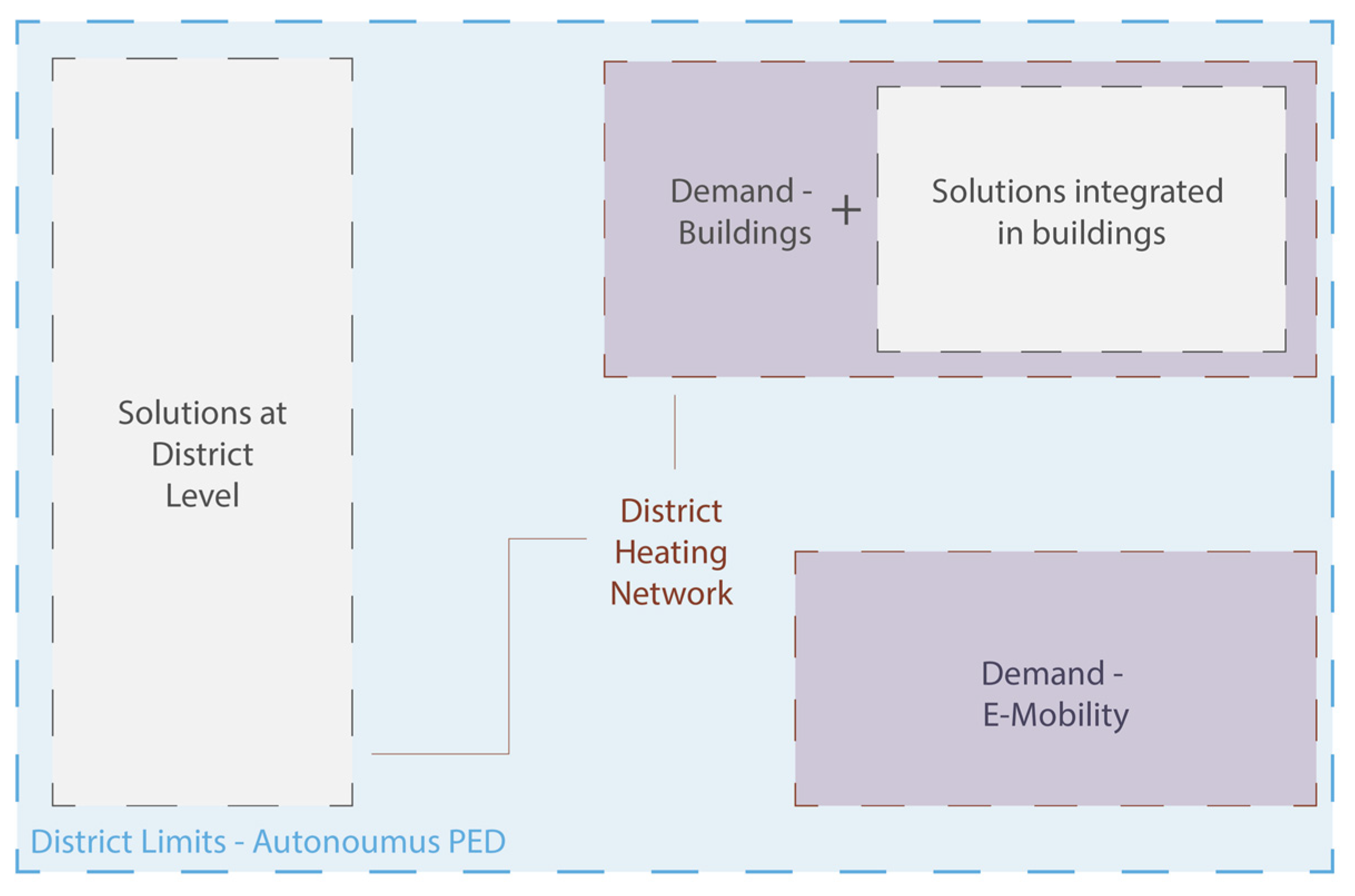



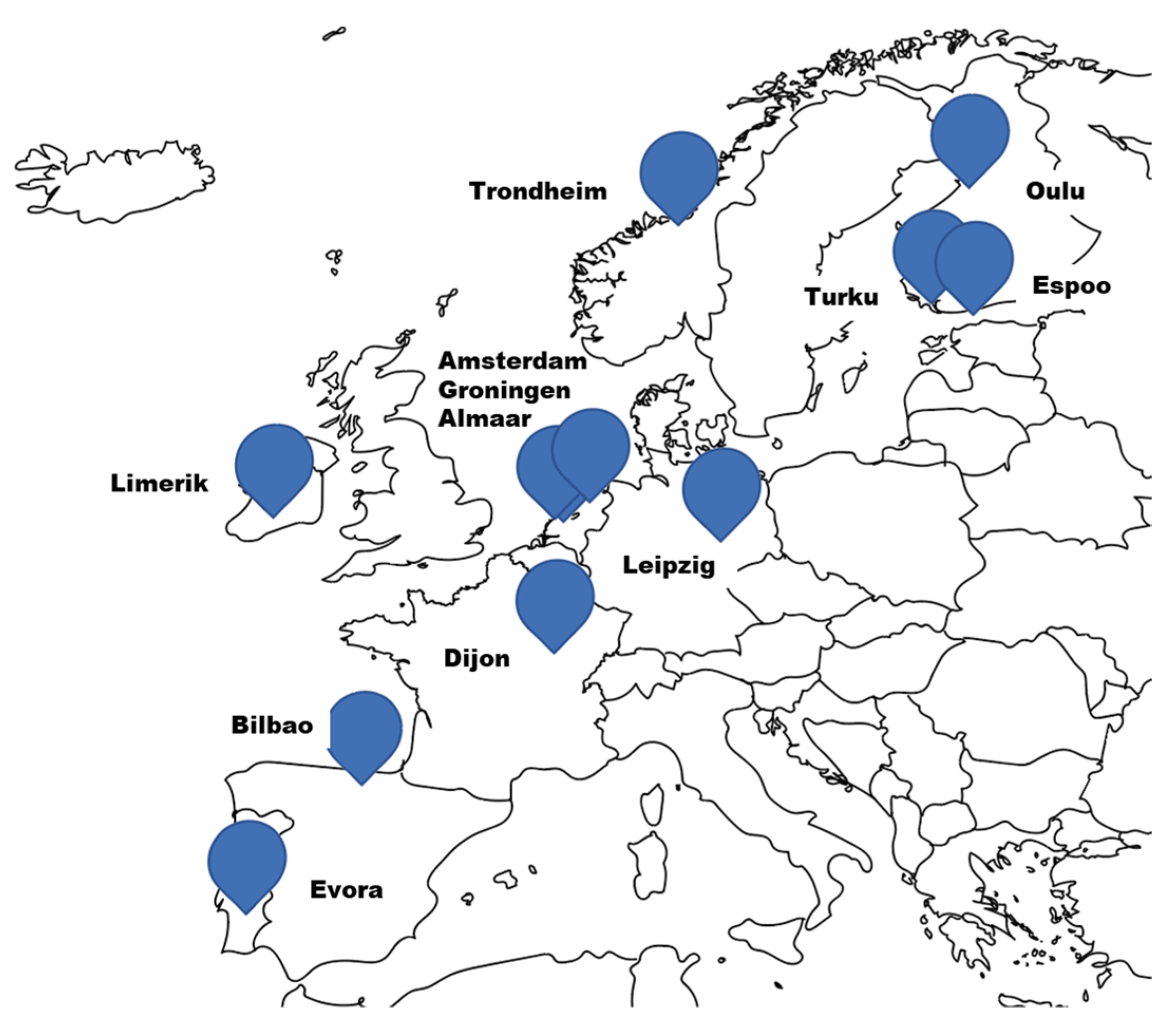
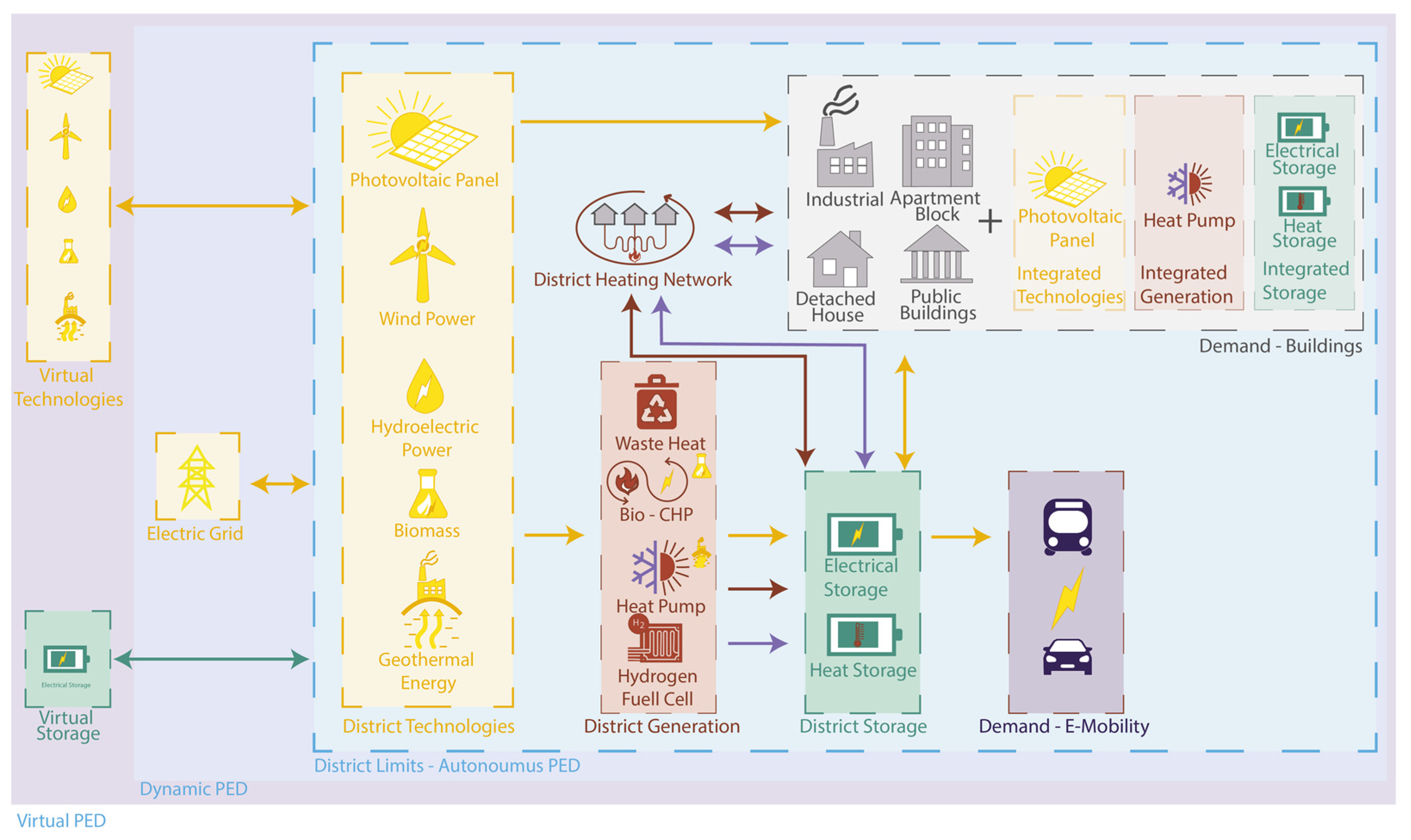

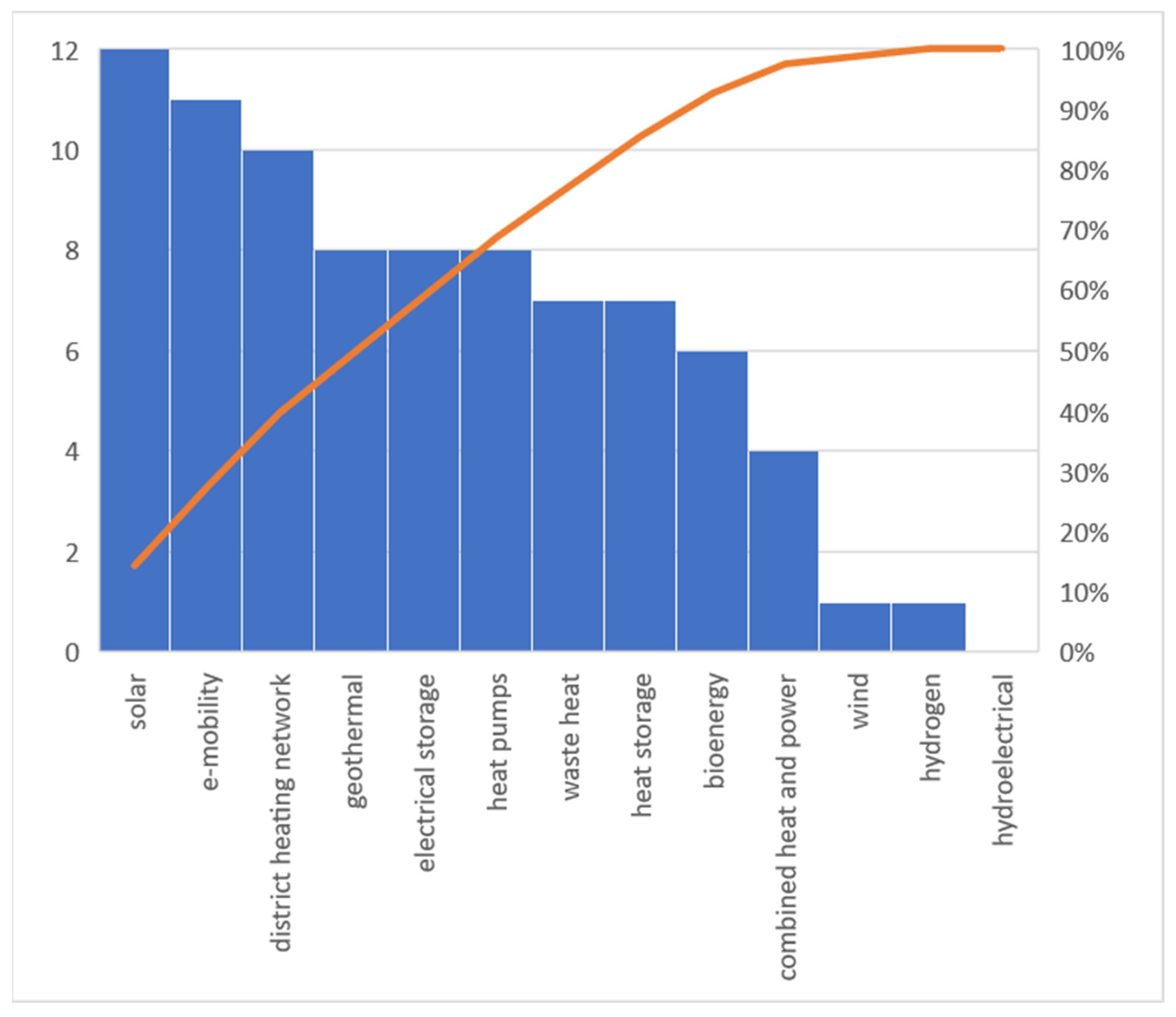

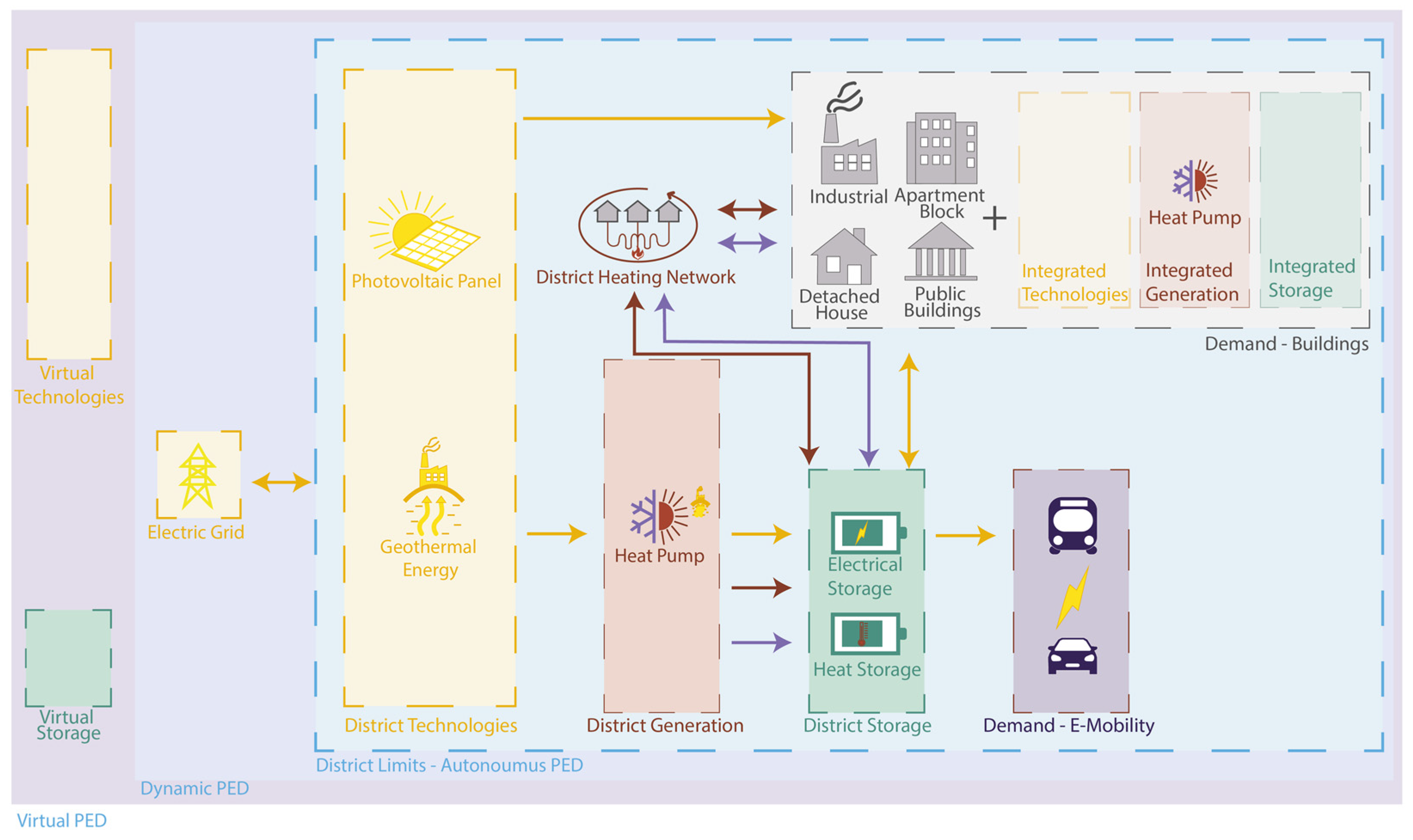
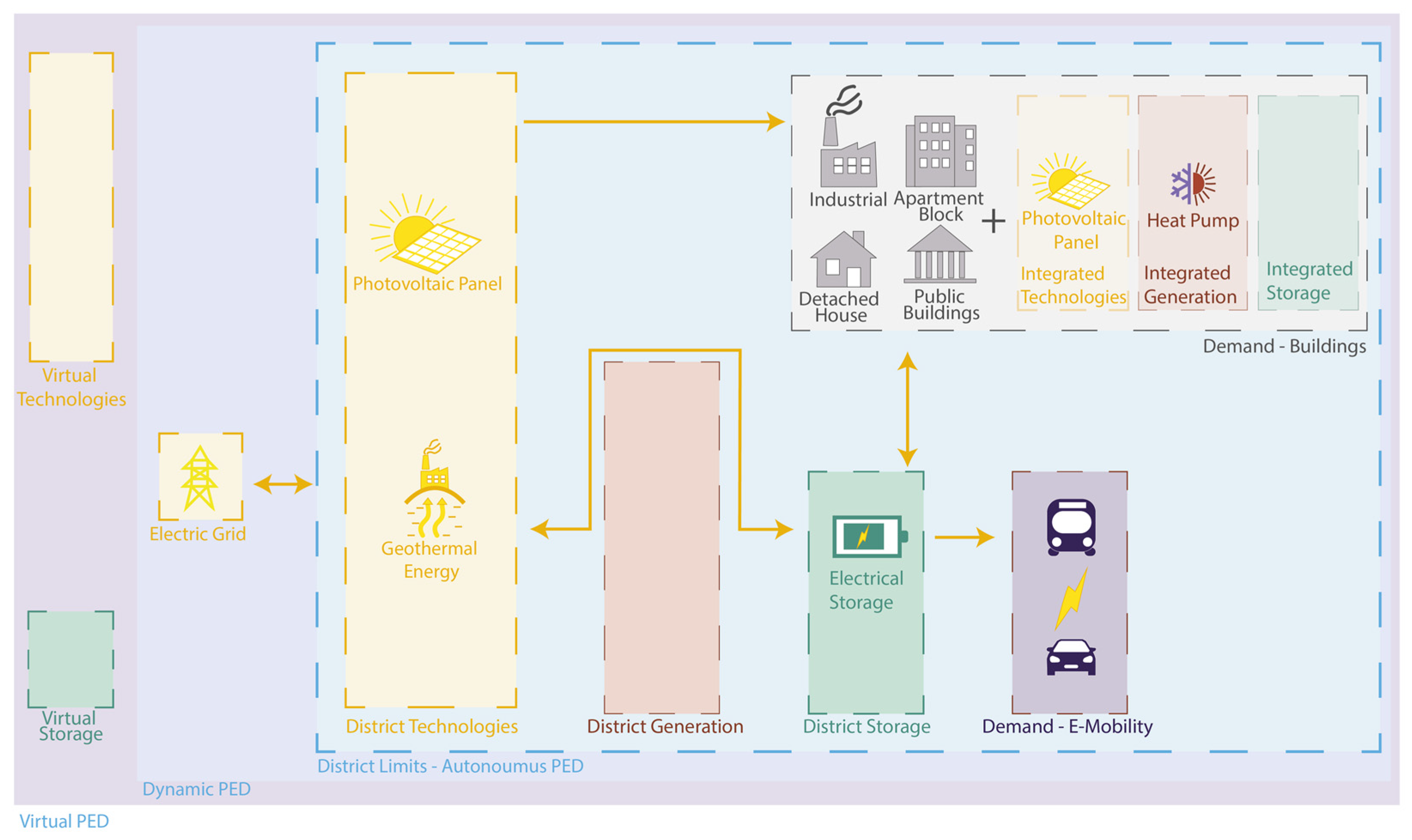
| Project Name | City | Website | References |
|---|---|---|---|
| Sparcs | Espoo (FI) | ESPOO | Sparcs | [58,59,60,61] |
| Sparcs | Leipzig (DE) | LEIPZIG | Sparcs | [62,63,64] |
| RESPONSE | Turku (FI) | Lighthouse Cities—RESPONSE (h2020RESPONSE.eu) | [65,66,67,68,69,70] |
| RESPONSE | Dijon (FR) | Lighthouse Cities—RESPONSE (h2020RESPONSE.eu) | [65,66,67,68,69,70] |
| Atelier | Amsterdam (NL) | General Information—ATELIER (smartcity-atelier.eu) | [71,72,73,74,75,76,77,78,79,80] |
| Atelier | Bilbao (ES) | Bilbao—ATELIER (smartcity-atelier.eu) | [72,73,75,76,77,78,79,80] |
| MAKING-CITYMAKING-CITY | Groningen (NL) | GRONINGEN–MAKING-CITY | [81,82,83,84,85] |
| MAKING-CITYMAKING-CITY | Oulu (FI) | OULU–MAKING-CITY | [81,82,83,84,85] |
| +CityxChange | Limerik (IR) | Our Cities—+CityxChange | [86,87,88,89,90,91] |
| +CityxChange | Trondheim (NO) | Our Cities—+CityxChange | [89,90,92,93,94,95,96] |
| POCITYF | Evora (PT) | Évora—POCITYF—POCITYF | [97,98,99,100,101,102,103,104] |
| POCITYF | Alkmaar (NO) | Alkmaar—POCITYF—–POCITYF | [97,98,99,100,101,102,103,104] |
Disclaimer/Publisher’s Note: The statements, opinions and data contained in all publications are solely those of the individual author(s) and contributor(s) and not of MDPI and/or the editor(s). MDPI and/or the editor(s) disclaim responsibility for any injury to people or property resulting from any ideas, methods, instructions or products referred to in the content. |
© 2022 by the authors. Licensee MDPI, Basel, Switzerland. This article is an open access article distributed under the terms and conditions of the Creative Commons Attribution (CC BY) license (https://creativecommons.org/licenses/by/4.0/).
Share and Cite
Leone, F.; Reda, F.; Hasan, A.; Rehman, H.u.; Nigrelli, F.C.; Nocera, F.; Costanzo, V. Lessons Learned from Positive Energy District (PED) Projects: Cataloguing and Analysing Technology Solutions in Different Geographical Areas in Europe. Energies 2023, 16, 356. https://doi.org/10.3390/en16010356
Leone F, Reda F, Hasan A, Rehman Hu, Nigrelli FC, Nocera F, Costanzo V. Lessons Learned from Positive Energy District (PED) Projects: Cataloguing and Analysing Technology Solutions in Different Geographical Areas in Europe. Energies. 2023; 16(1):356. https://doi.org/10.3390/en16010356
Chicago/Turabian StyleLeone, Federica, Francesco Reda, Ala Hasan, Hassam ur Rehman, Fausto Carmelo Nigrelli, Francesco Nocera, and Vincenzo Costanzo. 2023. "Lessons Learned from Positive Energy District (PED) Projects: Cataloguing and Analysing Technology Solutions in Different Geographical Areas in Europe" Energies 16, no. 1: 356. https://doi.org/10.3390/en16010356









